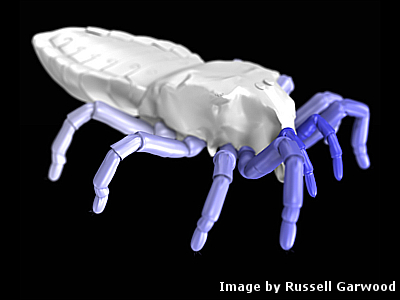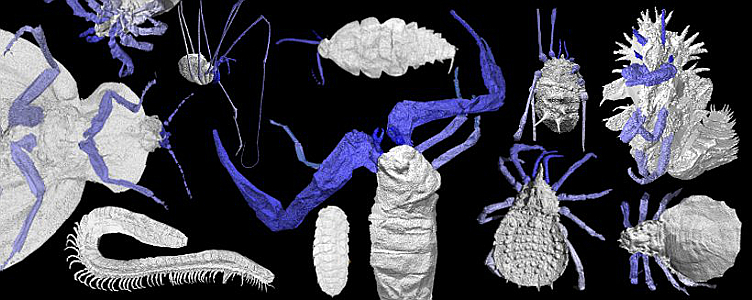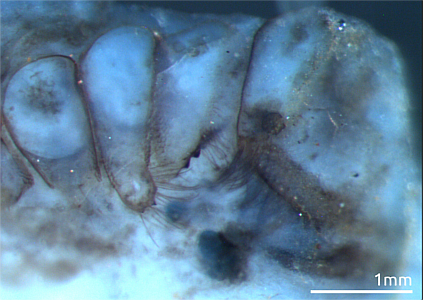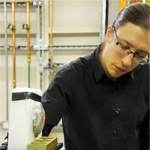Making the dead (Trigonotarbid) walk
Posted on 5 August 2014
Making the dead (Trigonotarbid) walk
 By Russell Garwood, 1851 Royal Commission Research Fellow at the School of Earth, Atmospheric and Environmental Science, University of Manchester.
By Russell Garwood, 1851 Royal Commission Research Fellow at the School of Earth, Atmospheric and Environmental Science, University of Manchester.
This article is part of our series: a day in the software life, in which we ask researchers from all disciplines to discuss the tools that make their research possible.
Palaeontology is often thought of as an antiquated field full of elderly researchers, but the discipline as it is today rarely matches this stereotype. Modern studies are multidisciplinary and use a diverse array of techniques to investigate the history of life. In some cases, palaeontologists can even make the dead walk.
When we think of the first animals to live on land we tend to imagine ungainly, fish-like creatures lolloping onto a beach somewhere around 385 million years ago.
However, as a palaeontologist who works on arthropods such as insects, arachnids, crustaceans and millipedes, I often argue that that this transition was not quite as important in the grand scheme of things as we would like to think. Around 430 million years ago, long before backboned animals came on to land, – the first creepy crawlies made this same monumental move. As such, working out where these arthropods came from, their early evolution, and their biology can tell us a great deal, not just about these important groups but about the early development of life on land, and evolution as a whole.
Some of the most valuable glimpses we get of early life on land come from sites that have exceptionally preserved fossils. With the aid of computational techniques and a range of open-source and proprietal software, modern palaeontologists can extract more information from these fossils than ever before.
For example, some of the earliest widespread preservation of land animals dates from rock laid down between 315 and 305 million years ago, a time period where dense forests covered much of the Earth’s continents. Through a number of factors including the geography of the continents, seawater chemistry, and climatic conditions, many of these fossils are preserved as three-dimensional voids within rock. Using high resolution CT scanning we can now use X-rays to extract the anatomy of these fossils in full from the rock, and digitally visualise them.

A range of different early land animals, alive around 315 - 305 million years ago, visualised in three dimensions with the aid of high resolution CT scanning.
There is, however, a fossil site that is even older. The Rhynie Chert, found in Scotland, UK, is a rock which preserved an entire 410-million-year-old community of plants and animals living near a volcano. Every now and then this community was inundated by a flood of water from a hot spring, whose dissolved mineral content would form a flint-like rock, or chert, preserving the flora and fauna in three-dimensions. Because the rock is translucent, Victorian scientists who discovered it realised you could make thin slides to study the fossils, a process which has allowed researchers better understand these early inhabitants on land.
Even though we can’t CT scan these fossils, as the fossils are made of the same stuff as the host rock and so X-ray techniques don’t work, we can however still study them using the same kind of digital techniques. In our recent study, Jason Dunlop, from Berlin’s Museum für Naturkunde, and I have described the leg articulations of an early arachnid, the Trigonotarbid Eophrynus prestvicii.
This creature was a member of an extinct lineage closely related to the spiders, whip spiders, and whip scorpions, and constitutes one of the very first predators known on land. By looking at slides showing its fossilised remains, we can work out how each part of the leg is jointed. The type of hinge tells us the range and direction of motion at each point in the limb, in the same way that the hinge in our own elbow allows more limited movement than the ball and socket joint in our shoulder.

Left: A fossil arachnid revealed by thinly slicing the rock. To the right are the animal’s fangs, whilst the hairy structures to the left are the base of its limbs. Photograph copyright Natural History Museum, London.
This information, along with all those slices of rock as a reference for the body allowed us to recreate the animal in the open source computer graphics software Blender. First we created a polygon mesh of the body and limbs. Doing so allowed us to map on the centre of mass of the animal as we assumed it was all made of one material. We then added an armature, or rigging, to the legs. This let us to use Blender to define the range of motion, and even stiffness of each joint. With the limbs correctly articulated, we could study the movement patterns of living arachnids, and narrow in on this animal’s probable gait.
So if, for example, the gait meant the centre of mass fell outside those limbs in contact with the floor at any time in the walking cycle, the arachnid would have fallen over. Such comparisons allowed us to suggest that this 410-million year old arachnid had an alternating tetrapod gait, in which four limbs would be in contact with the ground at any given time, whilst the other four would be moving forwards. There is a caveat in that this is the gait used by spiders that can vary said pattern by a fair amount depending on their speed and substrate. Nevertheless, by using a very limited subset of Blender’s diverse capabilities, coupled with careful study of the fossils, we have been able to approximate how this long-dead animal walked:
This is just one (fairly straightforward) instance of the computational, interdisciplinary approaches used by many modern palaeontologists. Amongst my colleagues I regularly see many other great examples, like using computational fluid dynamics to simulate the flow of water around early sea creatures, or engineering techniques such as finite element analysis, to study the biomechanics of extinct species, or discrete element analysis to model the interaction between a dinosaur’s feet and the sediments in which it left tracks. So, whilst we owe old fashioned palaeontologists a great debt, the discipline has moved on in recent decades towards an altogether more digital world.
Main image: An idealised reconstruction of this animal created from studying a large number of such sections, using the software Blender. The arachnids were ~ 2-6mm long in life.

